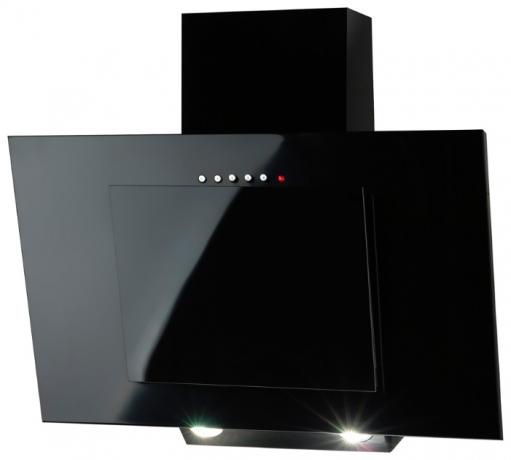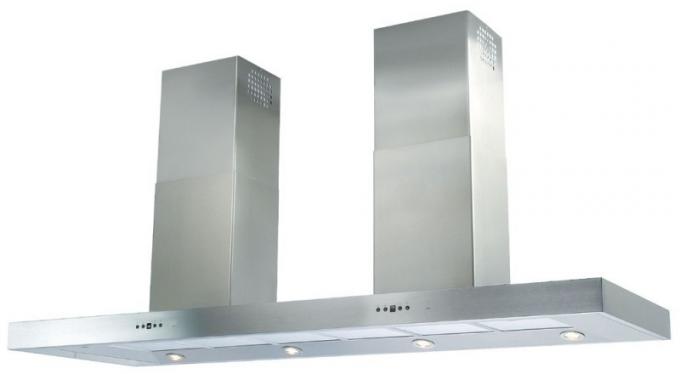Content
-
1 How hoods clean the air
- 1.1 Work principles
- 1.2 Rough cleaning
- 1.3 Fine cleaning
-
2 We ensure system performance
- 2.1 Filter care
- 2.2 Replacement procedure
One of the factors that determines how efficiently a cooker hood will work is the quality of its filters. In modern models of devices for removing and cleaning air, a variety of filters are used: metal and fabric filters to remove grease droplets, carbon filters for fine cleaning, etc.
In this article, we will dwell on the analysis of the most common types of air filters, and also talk about how to care for them.
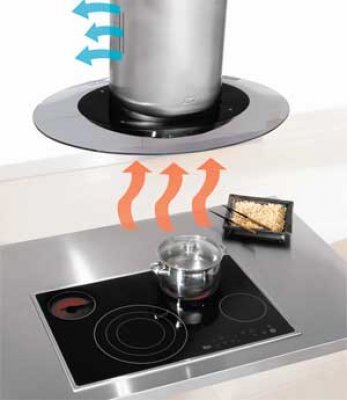
The air in the kitchen: was dirty, became clean
How hoods clean the air
Work principles
One of the main parameters by which different hoods differ from each other is the principle of their operation. Modern models are air-vent and recirculated.
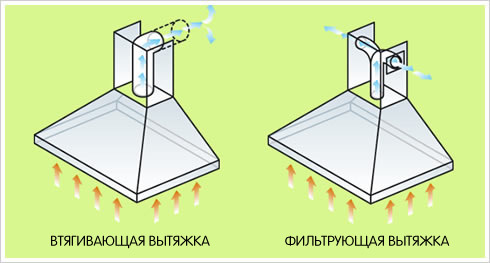
Diagrams showing the movement of air flows in different types of hoods
- Venting models remove polluted air from the kitchen. Typically, the venting model has a large enough dome to effectively capture steam and carbon dioxide, and is also equipped with a powerful engine. Air ducts for kitchen hoods are connected to the ventilation ducts of the building or removed from it.
- Unlike air exhaust, recirculating hoods pass all of the drawn air through a filter system and then return it back to the kitchen. At the same time, particles of grease, soot, dust, etc. remain on the filters, so that the air at the outlet becomes much cleaner.
Both types have advantages and disadvantages. For example, air vent structures are very cumbersome, and they work effectively only if if the ventilation ducts of the building are in satisfactory condition (let's also understand how to choose the right cooker hood).
As for filter hoods, not everything is clear with them either. Of course, they are more compact and do not require connection to ventilation ducts, but the air passing through them retains a high concentration of carbon dioxide and carbon monoxide. And the price for most recirculation models is very sensitive.
Rough cleaning
Depending on the type of hood, it can be equipped with either one filter for coarse air purification, or two - for both coarse and fine cleaning.
Special anti-grease filters are responsible for rough cleaning:
- The main task of this element is to trap microscopic droplets of fat, particles of soot, dust, kitchen debris, suspended in the air.
- A high-quality anti-grease filter, with proper care, is capable of trapping up to 92-95% of all air suspensions.
Note! Anti-grease protection additionally ensures the safety of the internal hood mechanism from damage. The thing is that with the ineffective operation of this unit, the fan axis and its blades are covered with a fatty coating and cease to cope with the load.
By design, these components are disposable and reusable.

Metal mesh for catching fat droplets
- Reusable produced in the form of cassettes with a fine metal mesh (pictured) arranged in one or more layers. For the manufacture of meshes, either anodized aluminum or galvanized steel is used. Reusable grease cassettes require periodic cleaning, but they are much more practical.
- Disposable grease catchers made of synthetic fabric (acrylic, padding polyester, etc.). They should not be reused even after washing, as when wet, the structure of the material is disturbed, and the efficiency of air purification is greatly reduced.

Universal disposable filter
Fine cleaning
Fine air purification implies, first of all, the removal of gaseous contaminants from it, including unpleasant odors.
It is carried out with special carbon filters:
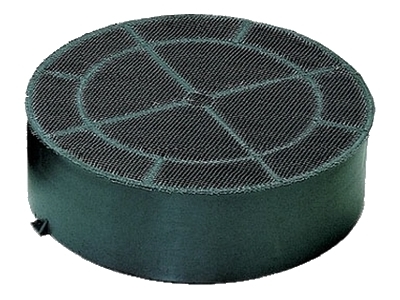
Carbon absorbent cassette
- Absorption carbon cassettes are placed inside the hood body behind an anti-grease grill, so that the air entering them does not contain large impurities.
- The plastic body of the carbon cartridge has a lattice structure that allows air to pass through the carbon core without obstruction.
- When the hood is in operation, the fan forces the air through the coal granules, where absorption takes place. Over time, the absorption efficiency decreases, because many models of hoods are equipped with special indicators that remind you of the need to replace components.
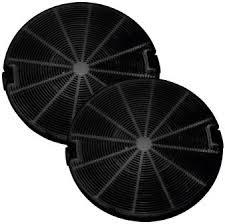
Spare parts for Ardo cooker hoods: cartridges with carbon granules
We ensure system performance
Filter care
In order for the accessories for kitchen hoods to serve you as long as possible, you need to take good care of them. The recommendations for caring for the filter system are simple, but following them can significantly reduce your costs of purchasing replacement filters (also find out all the features of the process of calculating the power of the hood for the kitchen).
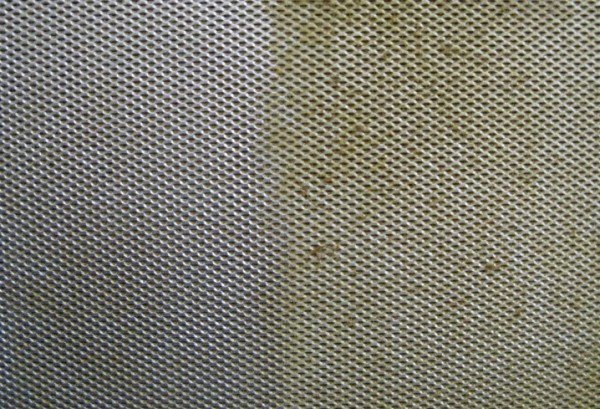
Clean and dirty areas on the grate
- Grease traps from a metal stack must be rinsed regularly. The more often you do this, the easier it will be to remove fat deposits.
- If the metal mesh is not too dirty, you can clean it with soapy water or dishwashing detergent. We remove a thick layer of fat with a hot solution of baking soda and laundry soap, or even a metal pipe cleaner.
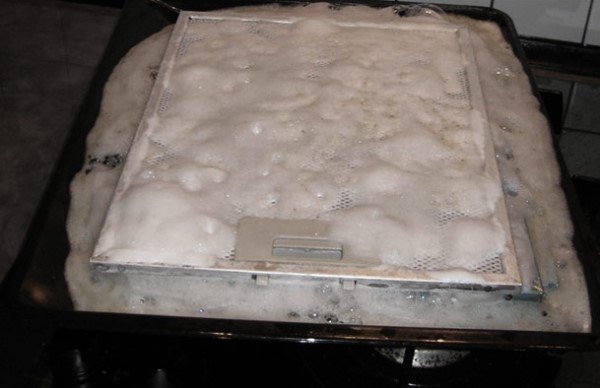
We wash off fat deposits
- Under no circumstances should the charcoal cartridges be washed, since the filler crumbles under the influence of moisture and loses its air-cleaning properties.
- Also, to extend the life of the fine carbon filter, leave the hood on for 15 minutes after finishing cooking. During this time, the engine will have time to drive air through the carbon filler several times, removing liquid vapors from it.
If you feel that the carbon filter has begun to work worse, you can try to restore its throughput. To do this, we treat the filter with a vacuum cleaner, removing the maximum possible amount of dirt.
However, this measure is temporary, and sooner or later the part will need to be replaced.
Replacement procedure
Contrary to popular belief, replacing a carbon cartridge for fine air purification is not particularly difficult even for those who have not previously dealt with hoods.
The instructions that we publish below will allow you to do the replacement yourself:
- First, disconnect the device from the power by removing the plug from the socket.
Note! It is imperative to completely de-energize the hood, since when replacing there is a risk of touching the engine start button.
- Dismantle the anti-grease grill by prying the mounts with your finger or a flat screwdriver.
- We take out the cassette with the carbon cartridge from the case. If necessary (depending on the design features of a particular model), unscrew the screws securing the cassette to the guides.
- We take out the used filter, replace it with a new one. We install the filter into the cassette until it clicks.
- We return the cassette to its place in the hood housing, after which we check the cassette fastening for the absence of backlash.
- We put in place the grease grid.

Replacing the carbon filter
After the replacement procedure, we immediately start the hood in trial mode - this way we can check that there are no installation errors.
The cooker hood filters shown in the photos and videos in this article are components whose importance cannot be overestimated. Despite their compact size, they do a tremendous amount of work, so proper care and timely filter replacement is a guarantee of clean air in your kitchen (also learn about the advantages of cooker hoods with a carbon filter).

